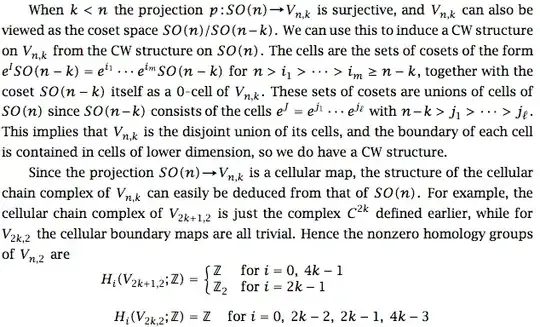I'm trying to (eventually) calculate the homology and cohomology of the space $T =\{(v,w)\in S^n \times S^n \mid v \perp w \},$ which is the unit tangent bundle, or sometimes called the Stiefel 2-manifold $V_2(\mathbb{R}^{n+1}).$ There are several ways to approach this: using a Gysin sequence (The circle bundle of $S^2$ and real projective space) or determining the cell structure of $T$ based on the cell structure of $SO(n)$, as done in Hatcher:  However, I am looking for an alternate way to solve this problem; in particular, the original hint I was given was to define $S_+ = \{(v,w) \in T \mid v_{n+1} \ge 0 \}$ and $S_- = \{(v,w) \in T \mid v_{n+1} \le 0 \}$,
where $v_{n+1}$ is the last coordinate of $v$ in $(v,w)$. Then I am supposed to prove that
$$S_{+} \approx S_{\text{north}}^+ \times S^{n-1}$$
where $S_{\text{north}}^+ = \{v \in S^n \mid v_{n+1} \ge 0 \}$. However, doing so has been driving me absolutely crazy.
However, I am looking for an alternate way to solve this problem; in particular, the original hint I was given was to define $S_+ = \{(v,w) \in T \mid v_{n+1} \ge 0 \}$ and $S_- = \{(v,w) \in T \mid v_{n+1} \le 0 \}$,
where $v_{n+1}$ is the last coordinate of $v$ in $(v,w)$. Then I am supposed to prove that
$$S_{+} \approx S_{\text{north}}^+ \times S^{n-1}$$
where $S_{\text{north}}^+ = \{v \in S^n \mid v_{n+1} \ge 0 \}$. However, doing so has been driving me absolutely crazy.
When examining the fiber bundle $p:T \rightarrow S^n$ s.t. $p(x,w) = x$, I know we have the local trivializations $$h_x: p^{-1}(U_x) \rightarrow U_x \times p^{-1}(x) \approx U_x \times S^{n-1}$$ where $U_x$ is the open hemisphere of $S^n$ that contains $x$ and is bounded by the tangent "plane" $P_x$ to $S^n$ at $x$ translated to intersect the origin of $R^{n+1}.$ In particular, $h_x(v,w) = (v, \pi_x(w))$ where $\pi_x$ is the projection onto $P_x$. This almost seems to work since local trivializations are isomorphisms. So by picking $x$ to be $e_1$, $P_x$ is the subspace $\{(v_1,...,v_n,0) \in \mathbb{R}^{n+1}\}$ and so $U_x$ is $\{v \in S^n \mid v_{n+1} > 0 \}$, which is close to $S_{\text{north}}^+$ but doesn't allow $v_{n+1} = 0$. Similarly, $p^{-1}(U_x) = \{(v,w) \in T \mid v_{n+1} > 0\}$ which is almost $S_+$ except for it excludes the case $v_{n+1} = 0$. Trying to just add on these points doesn't work since $h_x$ is not injective when $v_{n+1} = 0$ (or involves the projection of a vector being zero). How could I show $S_{+} \approx S_{\text{north}}^+ \times S^{n-1}$? I don't even feel that this statement is true.
UPDATE: (2/23) With help from the answer provided & comments, here is what I have (using the idea that a fiber bundle with contractible base is trivial).
Method (1): Define $U_+ = S^n \setminus \{-e_1\}$ and $U_- = S^n \setminus \{e_1\}$ so that $S^n = U_+ \cup U_-$ with $U_+, U_-$ open and contractible. Let $\tilde{T} = \{(v,w) \in U_+ \times S^n \mid v \cdot w = 0\},$ meaning (given the definitions in the problem statement) that $$ S_+ \subseteq \tilde{T} \subseteq T.$$ Let $p: \tilde{T} \rightarrow U_+$ be a fiber bundle. (We know at least one such fiber bundle exists since there is the trivial bundle sending $(v,w) \mapsto v$). Since $U_+$ is contractible, this fiber bundle is trivial; that is, $\tilde{T} \approx U_+ \times F$ where $F$ is the fiber. Specifically, for $v$ fixed $$F = p^{-1}(v) = \{(v,w) \mid v\cdot w = 0\} \approx \{v\} \times S^{n-1} \approx S^{n-1}.$$ So $\tilde{T} \cong U_+ \times S^{n-1}.$ Since restrictions of homeomorphisms are still homeomorphisms, we can restrict this homeomorphism to the closed subspace $S_{\text{north}}^+$ of $U_+$, so $$ S_{\text{north}}^+ \times S^{n-1} \approx \{(v,w) \in S_{\text{north}}^+ \times S^n \mid v \cdot w = 0\} = \{(v,w) \in S^n \times S^n \mid v \cdot w = 0, v_{n+1} \ge 0\} = S_+$$ by definition of hemisphere $S_{\text{north}}^+$ Thus, we have shown that $S_{+} \approxeq S_{\text{north}}^+ \times S^{n-1}.$ Is this argument correct? Is there some technical point I am missing?
Method (2): (This uses the stereographic projection suggestion.) Let $p: S(S^n \setminus \{x\}) \rightarrow S^n \setminus \{x\}$ be the unit sphere bundle of $S^n \setminus \{x\}$. Using the diffeomorphism $\Pi_x: S^n \setminus \{x\} \rightarrow \mathbb{R}^n$, we then have $$S(S^n \setminus \{x\}) \overset{p}\rightarrow S^n \setminus \{x\} \overset{\Pi_x}\rightarrow \mathbb{R}^n$$ is also a fiber bundle since $\Pi_x$ is a diffeomorphism. Since $\mathbb{R}^n$ is contractile, the bundle is trivial. Thus, $S(S^n \setminus \{x\}) \approx \mathbb{R}^n \times F$ where $F$ is $p^{-1}(\Pi_x^{-1}(v)) = S^{n-1}$ for any $v \in \mathbb{R}^n.$ So $$S(S^n \setminus \{x\}) \approx \mathbb{R}^n \times S^{n-1}$$ and by restricting $S^n \setminus \{x\}$ to its closed subspace $S_{\text{north}}^+$ (choosing $x \not \in S_{\text{north}}^+$), we have the homeomorphism $$S(S^+) \approx S_{\text{north}}^+ \times S^{n-1}.$$ However, $S(S^+) = S_+$ (right?) so $S_+ \approx S_{\text{north}}^+ \times S^{n-1}.$ Are there any technical points or general ideas that are wrong here?
Thank you.